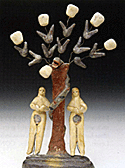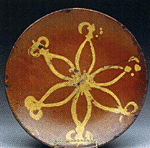Early Redware Came in Many Forms,
Decorations
When you think of the American earthenware known as redware, chances are what
comes to mind are plates to serve food and bake pies in. "Simple" and
"utilitarian" would be apt descriptions for its many humble uses. However, it
was also used in 18th and 19th century America for a diverse group of decorative
objects. The rust color was often replaced with green, red or yellow when the
objects were pipes, figurines or even coin banks.
Among the rarest examples
are mantle ornaments and figurines that were primitive copies of the then
popular English Staffordshire china pieces. These days, prices are anything but
humble, not only for the utilitarian pieces but decorative items, too. A coin
bank can sell for as much as $400 at auction; an unusual figurine can fetch
several thousand dollars.
Redware can trace its origins to Europe and
England, followed by the Pennsylvania Dutch who had settled in America. However,
the decorating techniques date to ancient times. The most common style of
decorating by the Pennsylvania Dutch was to use goose quills dipped in colorful
slip to form sayings, names, dates and abstract designs. The thin clay fluid was
a semi-liquid.
The other decorative technique, "Sgraffito" used a sharp-edged
wooden tool to incise or "scratch" a design on the semi-wet clay surface. The
potter began by applying a cream or yellowish slip color. Next, a hairline
design was incised into the piece and other colors such as green and yellow were
painted on the surface. When it was fired, the rust color of the clay showed
through.
It is often the technique that determines the price. Slip pieces
were made in large quantities, but since they were primarily used in the oven
and with eating utensils, a piece in good condition is considered choice. The
better the decoration, the higher the price.
By the 19th century, redware
plates became so popular that they were made as gift ceramics. The favorite
motif was the tulip, although roosters and floral motifs were also used. There
were so many variations of tulip designs that they became known as
tulipware.
Other popular motifs were eagles and other birds, flowers and
animals.
CLUES: Reproductions of sgraffito designed redware were first made
in the 1920s and '30s and are still being made. The repros don't show the proper
signs of wear and surface crazing. Some have a maker's mark.
Slip-decorated
pie plates rarely had a mark. However, the name of the pottery or the pottery
worker was sometimes decorated on it in slip. For instance, David Spinner of
Bucks County specialized in figures of soldiers, hunting scenes and fashionably
gowned women, decorated in sgraffito and slip.
If a finely decorated pie
plate is too perfect, be suspicious. They were used so much, they often have rim
chips and loss of the slip design. Since they can be costly, check to see if
they have been heavily restored. If you don't have an ultra-violet light, take
an expert with you before you pay too much. Or, get a written statement from the
seller saying if it is either a reproduction or has been restored, your money is
refundable.
Remember, since the designs are always in the unsophisticated,
folk art style, they can still turn up in garages and estate sales. Not everyone
knows what their history or value is.
|

Rare
redware figural of Adam and Eve.
(Photo:
James Julia Auctions, Fairfield, ME.)

Redware
slip-decorated
plate.
|